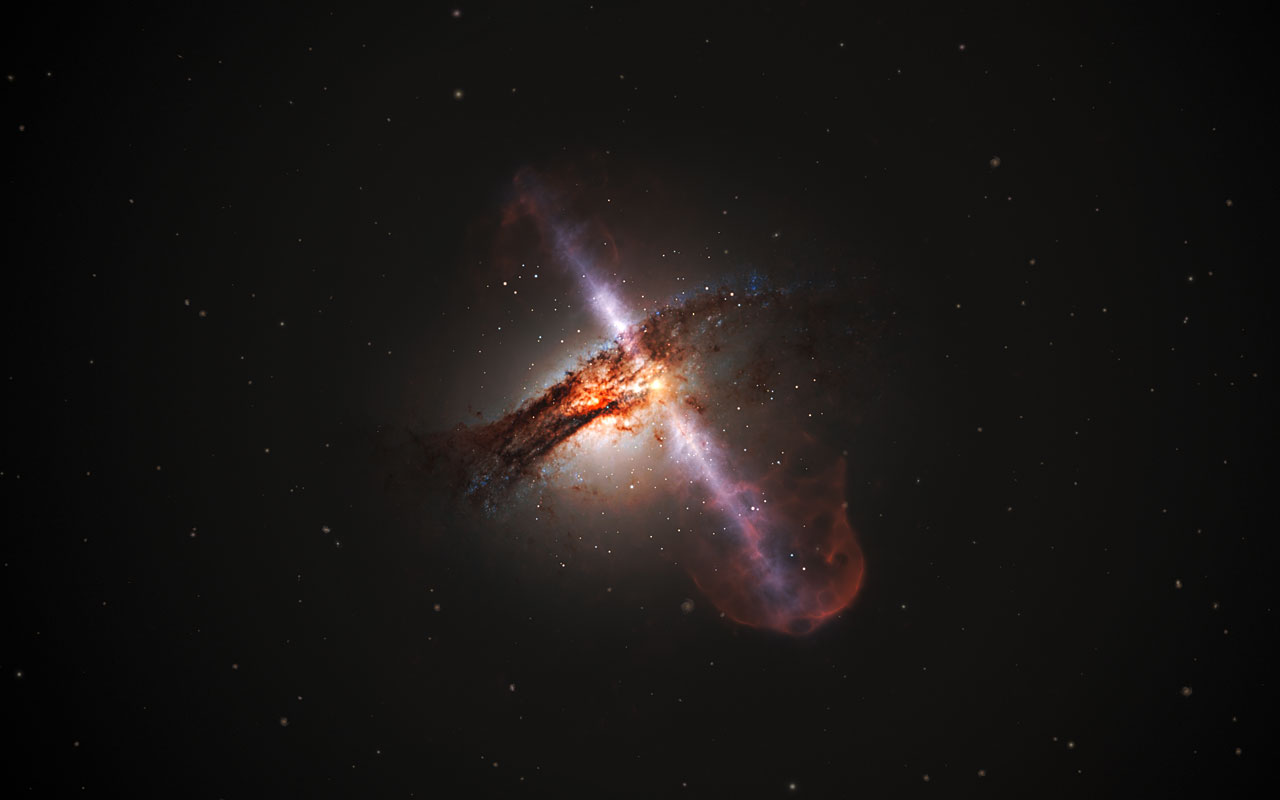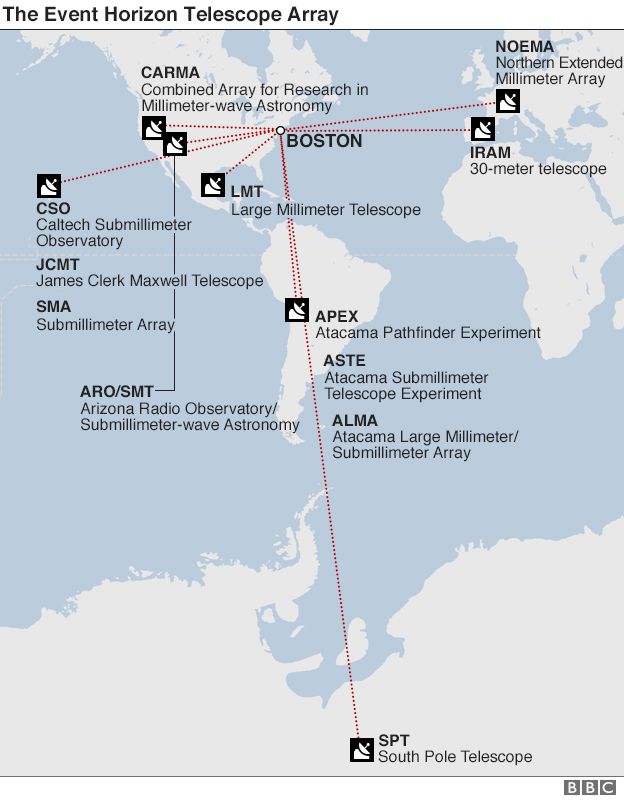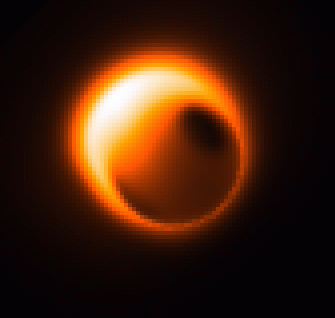Black holes are some of the most enigmatic objects in science. They have proved that science fact, is sometimes stranger than science fiction. Black holes are the super heavy remains of dead stars. They lurk everywhere, from the centre of galaxies right down to particle collisions in the centre of the CERN super-collider (never fear, they are super tiny!) Black holes in astronomic terms are measured in solar masses (1 solar mass = the mass of our sun = 1.99 x 10^30 kg). Those black holes who have a mass of a few solar masses we call "stellar mass" black holes (original!) and those of very high mass, like the ones in the centre of galaxies we call "super massive". The black hole at the centre of our galaxy, Sagittarius A* weighs in at around 4 million solar masses. That's pretty big! However, compared to some of the heavy-weights of the black hole world, that's pretty pathetic, with some of the largest black holes known coming in at a whopping 17 billion solar masses!!!!
With great mass, comes great curvature. When Albert Einstein published his general theory of relativity, humanity got a first look at the nature of curved space-time. We finally realised that gravity was purely a result of cured space, and that space was curved by heavy objects. The extent of the curvature was related to the mass of the object making the curve. An analogy always helps. Take a kids trampoline, and stand in the middle. The rubbery surface of the trampoline is space-time, and you are a heavy object, a planet or star perhaps. Now, go to your nearest safari park, and "borrow" an elephant, walk it back to your house, and stand it in the middle of the trampoline (this may require many tasty bribes!). Notice that the trampoline is now very much more curved than it was when you stood in the elephants place. This is the effect of massive objects on space-time. If you now take a ball, and roll it around the outside of the trampoline, you will see that it moves around the super-massive elephant in what could easily resemble an orbit. That is exactly what it is, in curved space-time, objects appear to move in straight lines (from the perspective of the object) but actually moves in curves, called orbits! At this point, you may give the elephant a well earned rub behind the ear, and return it to the park.
The point of this rather eccentric preamble, was to give a small introduction to the world of black holes, before discussing the main feature of this post, the "Event Horizon Telescope". Black holes are notoriously difficult to image. As the name suggests, they appear black (Mostly! if they are not feeding, and you exclude Hawking Radiation) and so don't appear in photographs. If the black hole is feeding, then it is possible to see the hot material swirling around the mouth of the black hole, in optical, UV, x-ray or Radio, with some stunning results.

Centaurus A is one of my favourite objects in the night sky. This image is a composite of many wavelengths. The disc of the galaxy can be seen as the dense band stretching from lower left to upper right, where as the very defined 'beam' like object moving in the opposite direction are 'black hole burps' jets of material being thrust away from the central super-massive black hole at, in some cases very close to the speed of light.
The aim of the Event Horizon Telescope, its to image the "Event Horizon" of the black hole. As the name suggests, this is the part of the object after which nothing can be observed. Its the point of no return, if you will. The event horizon of a black hole has never been observed directly, for many reasons. Black holes usually live in messy space, surrounded with dust, gas and the remains of last nights dinner, which makes optical observations impossible. Secondly, black holes are usually very far away (luckily for us) and are surprisingly small objects given their awesome mass (for reference, Sagittarius A* is 31 times the radius of the sun, but 4 million times the mass!!) This issue requires a telescope of a colossal size......the size of an entire planet!!!! In comes EHT!
The Event Horizon Telescope is comprised of radio and sub-millimetre telescopes dotted all over the world, which makes for a single unified dish the same diameter as the Earth itself, more than enough (hopefully) to take a decent image of the event horizon of our local super-massive black hole.

This array of telescopes has just completed its first imaging run, after which hundreds of hard drives have to be collected into one location, and all the data played in together, combined and output as a single image.
The key science objectives of the project, as listed on their website are;
- Testing General Relativity - Einstein's theory of general relativity predicts that there will be a roughly circular "shadow" around a black hole. The EHT aims to image the shadow to test this prediction and determine the mass of black holes
- Understanding accretion around a black hole - Black holes exert a strong gravitational pull on nearby matter. Some of this matter ultimately falls into the black hole in a process called accretion. One of the objectives of the EHT is to improve our understanding of the physics of accretion.
- Understanding jet genesis and collimation - Most galaxies show large scale jets of very fast moving plasma that are launched from the central black hole. One possibility is that these jets are launched very close to the rapidly-rotating central black hole. Most of these jets remain tightly confined to a narrow opening angle even far from the black hole. The EHT will improve our understanding of the process of generation and collimation of these jets.
(Objectives Credit - EHT Website: http://www.eventhorizontelescope.org/science/index.html )
What are we expecting the image to look like?? Well, something like this;

Even though this first image will be a few months off, its a really exciting piece of science, which I'm hoping will raise lots more questions than it answers. Its a really great place to study the laws of physics in an extreme gravity environment, which we simply cannot do here on Earth other than in super computers. The study of black hole event horizons may even give us some clues on how to start unifying general relativity to quantum mechanics, taking us toward the decadently named "Grand Unified Theory". No doubt that I will report back on this subject at a later date with more news.
I absolutely love black holes, and always talk about them in my outreach lectures. They seem to have the ability to captivate people of all ages, and if they understand the physics and maths behind them it doesn't matter, black holes are cool!!!


